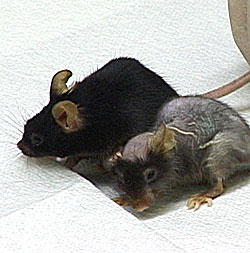
03.14.06
Is aging caused by a bunch of genetic typos? Genetics researchers have shown that turning off the body's spell-checker accelerates aging. This ScienCentral News video explains.
Why We Age
Why do we age? This may seem like a silly question. The more you drive, the less tread there is on your tires — simple wear-and-tear. Why should our bodies be any different? But would you still expect your tires to need replacing every 40,000 miles if they had a built-in system that sensed when rubber wore off and then re-grew it according to an internal blueprint?
That kind of repair is similar to what actually happens in our bodies, except the systems that keep us running smoothly are mind-bogglingly complicated and follow the instructions coded by our DNA. Old cells die and get replaced by new ones, virally infected cells commit suicide, DNA gets copied and spell-checked — theoretically, we should look and feel eighteen forever, yet we don't. Which failures in this system lead to aging, and why? Figuring that out is not just a matter of identifying the causes of wear-and-tear damage.
Genetics researchers led by Tom Prolla at the University of Wisconsin-Madison have gotten closer to understanding exactly why we age by looking at what happens in mice genetically altered to age faster. The fast-aging mice display all the typical signs of human aging: hair loss, graying, loss of hearing, decreased muscle mass, and general frailty. At the beginning of their lives the mice looked just like their normal counterparts, but by around nine months of age (the equivalent of 30 human years), they were physically like mouse-grandparents. "These mice age very fast, about three times faster than normal," Prolla says.
Normal and aged mice
As they reported in the journal Science, all of these physical changes were the result of a small change Prolla's team made to one gene in the mice's mitochondrial DNA.
"Mitochondria are very important for our cells because that's where we get all, or most, of our energy," he explains. These tiny energy factories are found in every cell of our bodies, but unlike any other cell sub-structures, mitochondria have their own DNA. Each time a cell copies its DNA in preparation to divide, the mitochondria in the cell also copy their own small genomes. Then, when the cell splits in two, each daughter cell gets an identical copy of both the mitochondrial and the cellular sets of DNA.
The gene that the team modified is the mitochondrial PolgA gene, which contains instructions for making the enzyme DNA polymerase gamma. This enzyme is normally responsible for copying and spell-checking mitochondrial DNA. The team changed just two letters, or bases, of the gene's DNA code. "We altered two bases in the gene and made it defective so that it can now function in the copying of the DNA but can no longer function as a spell-checker," Prolla explains. "As a result of that, the mitochondrial DNA accumulates mutations."
The researchers concluded that this increased number of mutations (3 to 8 times as many as in normal mice) was the reason for the increased rate of cell-suicide that they observed in the fast-aging animals. Because of those mutations, cells that make up many parts of the body — from hair to bone to muscle — prematurely committed suicide.
Another popular theory of human aging is called the "free radical theory." Free radicals are chemicals that accumulate in our cells from the environment that can react with and damage DNA. Prolla's team measured the levels of a common free radical in the normal and mutant mice at different ages — but they found no difference. This led the team to conclude that the higher rate of cell death could cause aging even in the absence of free radicals.
Prolla says that this is the first time that programmed cell death has clearly been linked to aging. Prolla thinks that this premature cell death likely destroys stem cells, which cannot easily be replaced. "Once they're lost, the tissues which they support will no longer be able to regenerate," he says. "So the loss of stem cells is probably a critical feature of accelerated aging."
The team's next step is to test whether interventions can slow down how rapidly these mice age. "This is a very important finding because it suggests ways which one can interfere in the aging process. For example, replacing lost stem cells," Prolla explains. He also suspects that there are other genes in mitochondria that can prolong life.
So who knows — we may well be on our way to eternal youth. With all these clues as to why our repair systems fail, it looks like at the very least, future technologies will include ways to prolong our lives. Unfortunately, though, our tires will probably continue to need regular replacing.
Prolla's research was published in the July 15, 2005 issue of Science, and was funded by the National Institutes of Health and the American Heart Association.




